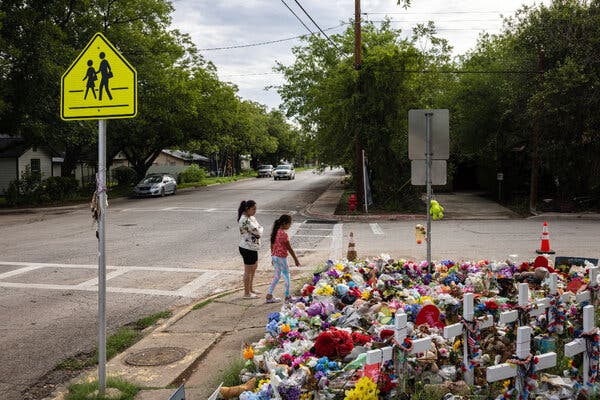More than three years after the devastating mass shooting at Robb Elementary School in Uvalde, Texas, questions remain about why the incident commander chose to negotiate with the shooter instead of immediately breaching the classroom where the attacker was barricaded with numerous children.
Pete Arredondo, the commander in charge, classified the assailant as a barricaded subject rather than an active shooter—a critical determination that is central to his upcoming trial. He faces charges related to neglecting or endangering the children under his protection. The attack resulted in the deaths of 19 students and one teacher, with 17 others injured.
Newly released video footage from Tuesday reveals that Arredondo, who led the Uvalde School District police and was the senior officer first on the scene in 2022, spent over 30 minutes attempting to communicate with the gunman. The shooter remained inside two adjoining classrooms, accompanied by two teachers and 28 students, some of whom were still alive during the standoff.
The videos, part of a large collection of law enforcement materials made public on Tuesday, provide one of the clearest insights yet into Arredondo’s conduct during the critical moments following the shooting. The footage captures him urgently pleading with the shooter to surrender, even as sporadic gunfire continued.
At 11:59 a.m., approximately 30 minutes into the shooting, Arredondo is heard through the classroom door addressing the attacker: “Individual in room 111 and 112, this is Arredondo, can you please put your firearm down?” He repeated similar appeals in both English and Spanish, but received no response.
He continued, "We don’t want anyone else hurt, sir," followed by, "These are innocent children, sir."
The footage also captures mounting frustration among officers from various agencies present at the scene.
An officer’s body camera records a colleague stating at 12:21 p.m., "If we need to jump in, we’ll jump in," signaling readiness to act despite the stalled situation.
Two minutes later, Arredondo’s voice again breaks the silence: “Please don’t hurt anyone. These are innocent children.”
At one point, an officer nearby asks another, “Has he talked?” The response is a firm “No.”
The breach did not occur until 77 minutes after the initial gunfire, when a Border Patrol tactical team entered the classrooms, confronted the shooter, and ended the attack by killing him.
Investigations conducted by federal and state authorities concluded that Arredondo erred by failing to maintain the classification of the suspect, Salvador Ramos, an 18-year-old former student, as an active shooter throughout the incident.
Retired FBI crisis negotiator Gregory M. Vecchi, after reviewing part of the newly released transcripts, asserted that standard protocol in mass shooting situations requires officers to neutralize the threat immediately rather than attempting negotiation.
"The protocol is to go in aggressively and take care of the threat because kids are being killed," Vecchi said. "There is no barricade. There is no negotiation."
Initial attempts by police to enter the classrooms were repelled when the shooter fired on them, injuring two officers.
Arredondo has explained that his focus was on evacuating children from nearby classrooms and awaiting better-equipped backup forces while continuing efforts to persuade the gunman to surrender. He, along with junior officer Adrian Gonzales—who also faces charges—maintains that their actions adhered to proper protocols given the difficult circumstances.
Another body camera video, released on Tuesday and recorded by a Uvalde County sheriff’s deputy, shows officers assembled in the hallway outside the classrooms, some with weapons drawn, debating how to proceed. One officer inquires over the radio whether the door is open, closed, or locked and whether it needs to be forced open.
The footage ends abruptly, leaving unclear if the officers attempted to open the door sooner.
Earlier investigations revealed that officers searched for keys to the classroom door, unaware that it was actually unlocked.
This delay may have had fatal consequences. While most children and one teacher inside had already been shot, some remained wounded and alive. At least one child was quietly calling 911 for assistance. A surviving teacher reported hearing gunshots directed at children in adjacent classrooms during the period officers waited outside.
The extensive documents and videos released this week conclude a prolonged legal dispute between local authorities and media organizations seeking transparency.
Written reports from responding deputies indicate they were instructed not to engage the shooter without prior authorization. One deputy noted, “I was informed we could not enter through the southern entrance due to a possibility of crossfire,” referencing concerns over friendly fire.
Footage depicting the chaotic conclusion of the 77-minute standoff captures gunfire at approximately 12:50 p.m. Officers then rush into the classrooms. Two minutes later, Arredondo is seen behind the rescuers, with an officer instructing, “Anyone who is not a medic, please clear out.”
More than 370 officers from local, state, and federal agencies responded to the incident, though many remained outside the school grounds. Arredondo has stated that he did not consider himself in command once additional personnel arrived, although state officials later identified him as the effective incident commander. Several senior officers from various departments have since been dismissed or retired.
The newly disclosed records also provide insight into Salvador Ramos’s background, tracing his transformation from a friendly child to a teenager exhibiting behavioral challenges that teachers struggled to manage.
Early educators described him as a “sweet little boy,” but documents reveal an increase in violent conduct with age.
A school report from May 2018 detailed physical altercations, noting, “Salvador went up to a student and hit him in the arm. Another student reacted by kicking him.”


0 Comments
No comments yet. Be the first to comment!